The Dell XPS 13 (9300) Review: Return of the King
by Brett Howse on July 16, 2020 10:00 AM ESTSystem Performance
When we reviewed the XPS 13 2-in-1 back in November, it was the first device we had tested which featured the new 10 nm Intel Ice Lake platform. At that time, Dell had also recently refreshed the XPS 13, but had outfitted it with the older 14 nm Comet Lake platform. For the all-new XPS 13, Dell has now brought parity to their lineup with Ice Lake here as well, with the improvements that platform brings, especially to the graphics side.
Dell offers three processor options. The least-expensive offering is the Core i3-1005G1, the mid-tier outfitted with the Core i5-1035G1, and the top-tier offering the Core i7-1065G7. Our review unit features the Core i7 model, as Dell wanted to put its best foot forward.
On the memory side, Dell’s spec sheet shows a 4 GB base, although thankfully that is nowhere to be found on their Dell.com site, at least for the USA. Thanks to the move to LPDDR4X with Ice Lake, Dell now offers up to 32 GB of memory on the XPS 13. Storage is all PCIe x4 NVMe, with 256 GB as the base, and a 2 TB maximum.
To see how the XPS 13 performs, we have run it through our newly updated laptop suite. Please not that if a graph does not contain a specific older device, that means that the test has not been run on it. Since the laptops are returned to the manufacturer after review, we cannot do any regression testing for the most part. If you’d like to compare the XPS 13 to any other laptop we have tested, please refer to our Online Bench.
PCMark
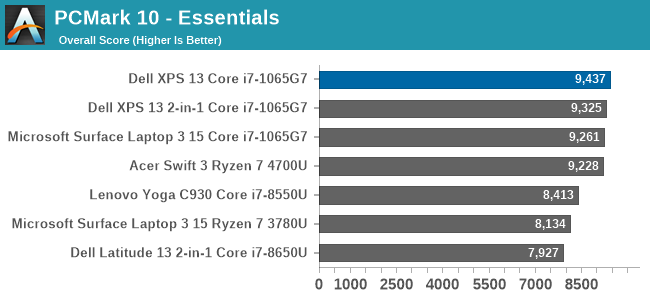
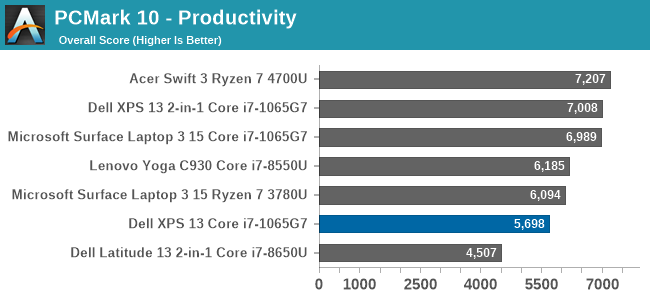
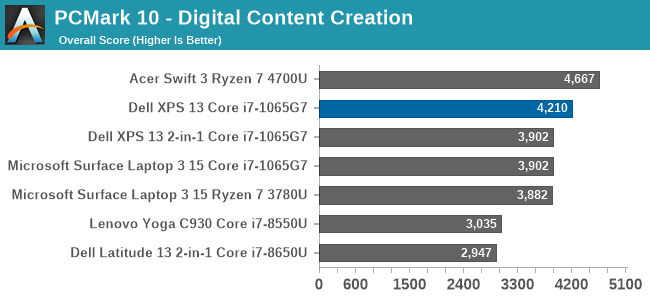
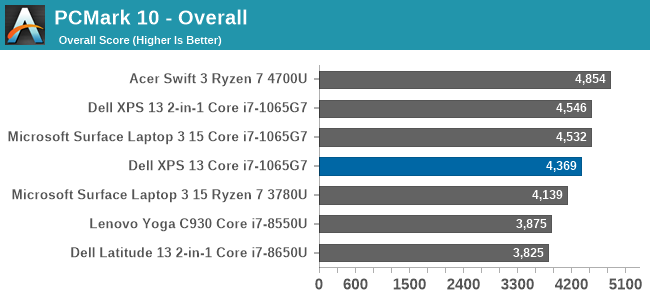
UL’s PCMark 10 is a whole-system benchmark, testing everything from CPU performance to app loading time. The Overall score consists of three categories, each featuring their own unique sub-tests. Overall the XPS 13 scored right in the same ballpark as other Ice Lake notebooks, although was slightly down in the Productivity tests, but slightly ahead in the other two.
Cinebench
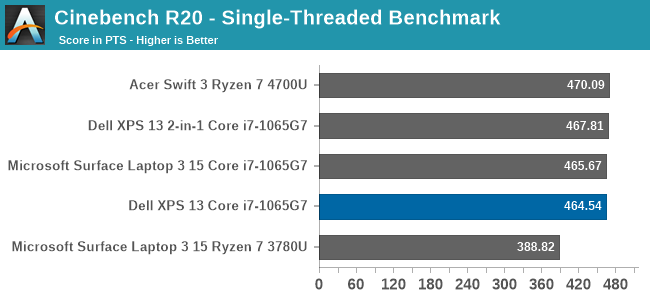
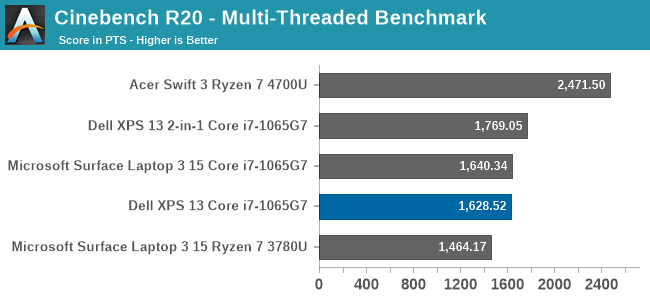
Cinebench, based on Maxon’s Cinema 4D rendering, allows tests of both single-threaded and multi-threaded runs, making it one of the more popular tests for overall computational performance. The XPS 13 does well compared to other Ice Lake equipped notebooks, although with AMD offering up to 8 cores in the same 15-Watt TDP, Intel falls behind in the multi-threaded run.
Handbrake
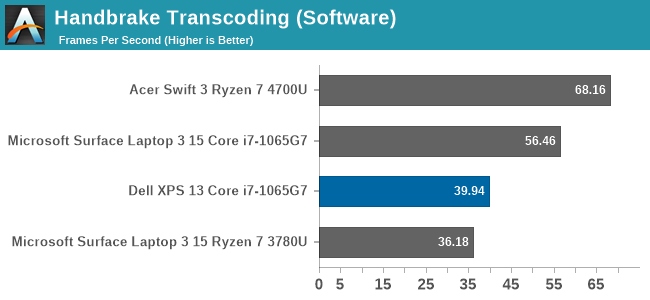
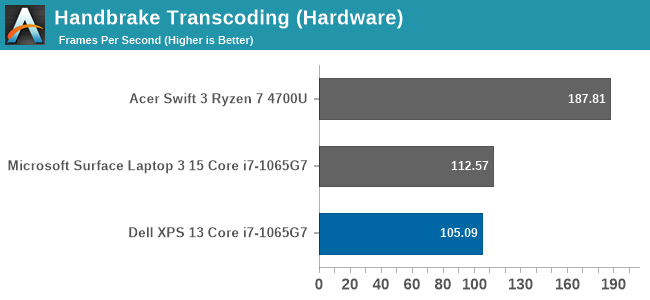
In our Handbrake encoding test, we transcode a 1080p movie to 720p using both software and hardware encoders. Software encoders utilize the CPU, and are generally the preferred method for optimal quality, whereas hardware encoders leverage the media blocks, which in this case is Intel’s QuickSync, for a much faster encode. As we will see more in the thermals section, Dell limits the XPS 13 to a 15-Watt TDP even in its maximum performance mode, where some other manufacturers will allow for higher than listed TDP, up to 20 Watts or so, and as such, the XPS 13 falls a bit behind other Ice Lake notebooks in this test which is TDP limited.
7-Zip


The popular file compression and decompression tool 7-Zip includes a built-in benchmark, and once again the XPS 13 slots right into where other Ice Lake notebooks fit.
Web Tests
Web performance is a function of not only the CPU performance, but also the browser’s scripting engine, and as such we have standardized on the Microsoft Edge browser. Microsoft has now transitioned their browser to the open-source Chromium project. Due to this, we have reset our web tests to use the new Chromium based Edge and taken the opportunity to decommission some of the older tests. We will now focus on Speedometer 2.0 and WebXPRT 3.
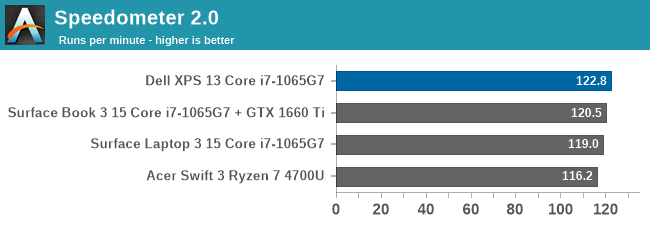
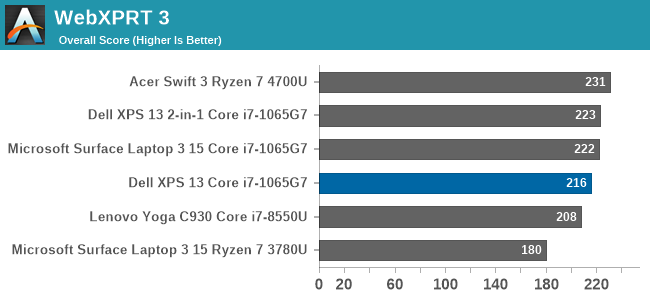
The XPS 13 again slots right in where you would expect for an i7-1065G7 based system.
Storage Performance
Dell offers from 256 GB to 2 TB of PCIe storage, and the review unit was outfitted with the Intel 600p 512 GB drive. We are transitioning to the PCMark 10 storage benchmark, which uses test traces of actual common workloads, such as booting Windows, and many of the Adobe applications, and as such should be a much better indicator of drive performance than just maximum transfer rates.
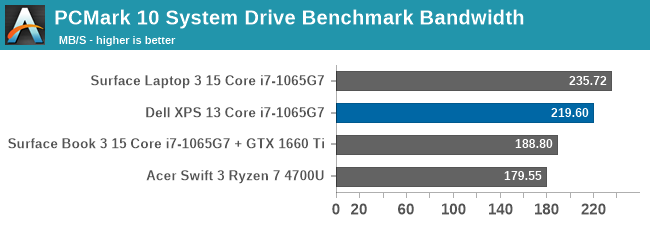
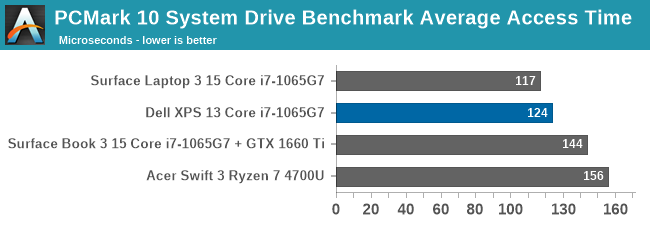

The Intel 600p performs quite well, with good access times and solid bandwidth. Surprisingly, it can’t quite match the excellent performance we saw from the SK Hynix 2230 form factor SSD in the Surface Laptop 3, but almost matches it.











224 Comments
View All Comments
Jorgp2 - Thursday, July 16, 2020 - link
>Zen 2 mobile chips easily outperform Ice Lake and Comet LakeOnly in multicore, and only because they have 8 cores.
The Zen 2 architecture still has around Skylake level performance, SNC and WLC have a much higher lead over Skylake than Zen 2 does.
rhysiam - Thursday, July 16, 2020 - link
On what basis are you announcing Sunny Cove and the unreleased Willow Cove as superior architectures? Can you link to some data to support that? Because this review directly contradicts that claim.The lightly threaded tests in this very review show the 4700U trading blows with the 1065G7. Both are clocked similarly. IPC is close in workloads that are relevant to ultrabooks.
I just can't see any basis for the claims you are making here.
Deicidium369 - Friday, July 17, 2020 - link
Comparing a 2020 CPU with a 2019 CPU is not a fair comparison.sorten - Thursday, July 16, 2020 - link
Most of what I do as a software engineer, from the compilers, build tools, and the software I write, eats up the cores. So if I can get 2x the cores for less money, then that's a bonus rather than a point against AMD.vladx - Friday, July 17, 2020 - link
As a fellow software engineer, I still prefer Intel over AMD. What you win with having more cores, you lose with poor compiler optimizations and the big advantage of AVX-512 in certain workloads. Not to mention AMD platforms tend to have more bugs at launch so you spend more time finding workarounds.Spunjji - Friday, July 17, 2020 - link
@vladx with the FUD here. Nice weasel words with "tend to have more bugs" even though we're talking about a specific platform that doesn't have any egregious bugs.Santoval - Friday, July 17, 2020 - link
"and the big advantage of AVX-512 in certain workloads. "Can you name some of these workloads? Even better, out of 10 workloads (or, to make it temporal, out of every "10 programming hours") on average how many can benefit by or be accelerated with AVX-512? Hand on heart answers only please.
As for the "poor compiler optimizations" do you mean the "super aggressive compiler flags Intel tends to prefer that often result in poorer, bug prone code"?
Spunjji below covered me with the arbitrary "bugs" of the "AMD platforms".
Santoval - Friday, July 17, 2020 - link
"The Zen 2 architecture still has around Skylake level performance, SNC and WLC have a much higher lead over Skylake than Zen 2 does."That is pure, groundless BS. You have also confused the Zen 2 "architecture" (thus only the *IPC* of Zen 2) with Skylake's "performance" (both its IPC and clock speed). That is like comparing the acceleration from 0 to 60/100 of one car with the final speed of another car without even realizing the arbitrary comparison.
Finally CPUs with Willow Cove (i.e. Tiger Lake) has not even been released yet, so referring to Willow Cove in the present tense is beyond surreal.
dudedud - Friday, July 17, 2020 - link
Did you even see the Cinebench single threaded results? Zen 2 has Ice Lake performance at around the same clock (4.1 vs 3.9)Brett Howse - Friday, July 17, 2020 - link
There seems to be a lot of misinformation flying around here. Perhaps I should link to our initial Ryzen 7 4700U review in every review I do. Ice Lake is well ahead in single-threaded performance over Zen 2, despite the lower frequency. AMD has double the cores though so even lightly threaded workloads can see a nice improvement.Please reference this:
https://www.anandtech.com/show/15762/the-acer-swif...
Cinebench is just a single workload and is compute bound.
Hopefully we can update our SPEC results with a LPDDR4 laptop as well since our first take was just DDR4.